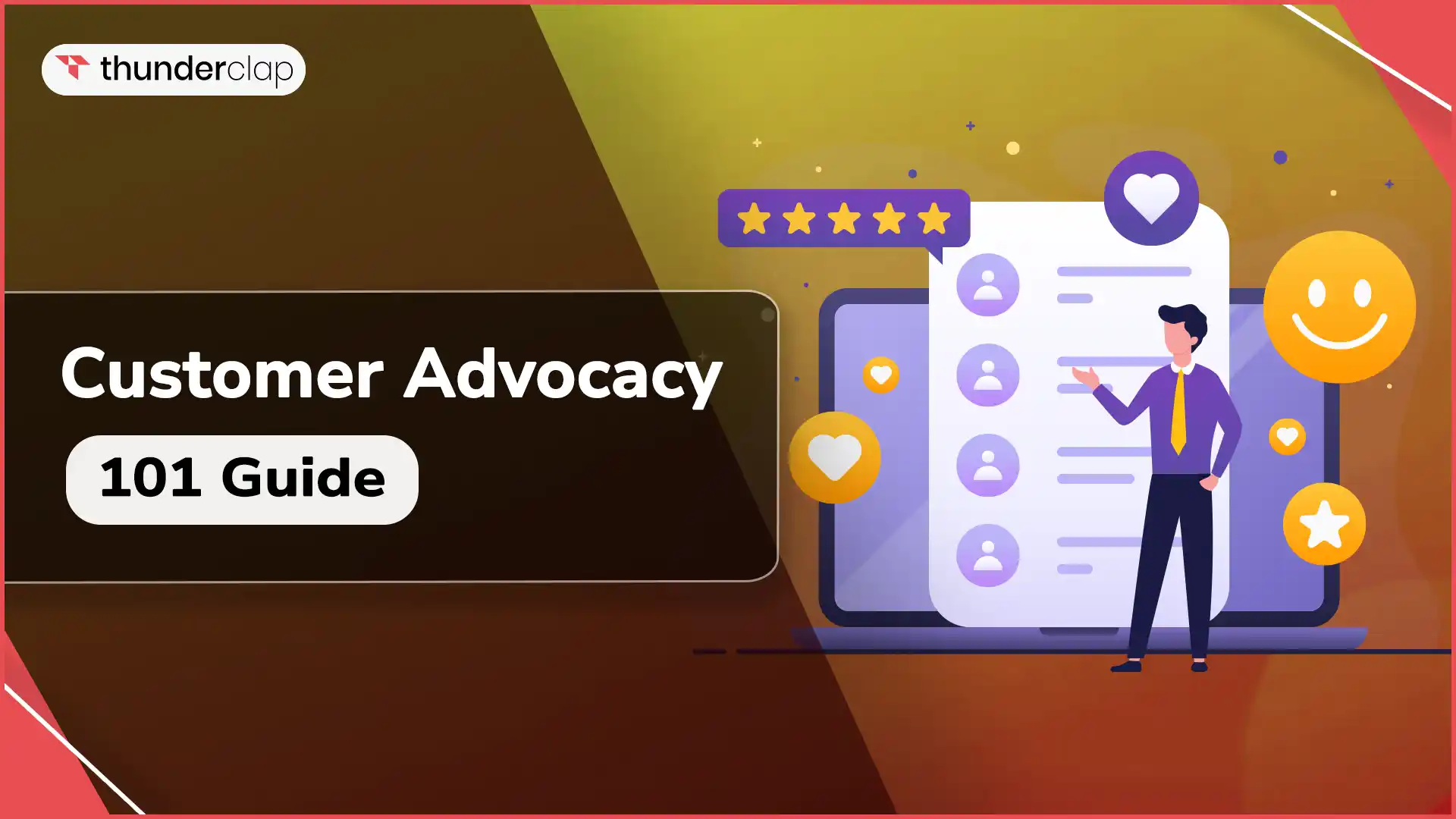In the competitive business landscape, customer loyalty is no longer a luxury, it's a necessity. Businesses that prioritize customer satisfaction and cultivate genuine connections with their audience are the ones that thrive.
Customer advocacy goes beyond simply having satisfied clients. It involves turning satisfied customers into enthusiastic supporters of your brand, actively endorsing your products or services.
Cultivating customer advocacy yields immense rewards. Their praise draws new buyers organically - a self-sustaining cycle propelling customer delight, brand loyalty, and business expansion.
In this guide, we'll explore customer advocacy, defining its importance and sharing methods to build a passionate brand advocate community. By the end, you'll have the knowledge and tactics to turn satisfied clients into your most powerful marketing asset.
What Is Customer Advocacy?
Customer advocacy is more than just a thumbs-up or a positive review. It's when customers become active champions for your brand, product, or service. They proactively recommend you to others and share their positive experiences through recommendations, social media posts, online reviews, or even user-generated content.
Building trust and connection happens through consistent efforts in creating excellent customer experiences, personalised interactions, and forging emotional ties with your brand. When customers consistently receive great service and feel valued as individuals, they start to develop a deeper connection with your brand.
This connection grows stronger when it resonates with your brand's mission and values, leading to a sense of loyalty and passion. As this emotional bond deepens, customers become advocates, willingly promoting your brand because they genuinely believe in it and its mission.
This makes them incredibly valuable. Their recommendations and testimonials hold significant weight, positively impacting your brand reputation, credibility, and customer acquisition. Positive praise from trusted people is a powerful marketing tool for your business.
Why Is Customer Advocacy Important?
Customer advocacy isn't merely a passing trend; it's the key to building a loyal customer base that fuels business growth. Here's why cultivating a community of brand champions is essential:
-
Boosting Sales
Customer advocacy acts as a powerful sales engine by nurturing loyal customers who are more inclined to make repeat purchases, ensuring a steady revenue stream. Advocates, who spend up to twice as much as non-advocates, significantly boost the average customer value.
Additionally, they serve as effective promoters, influencing others through word-of-mouth marketing, thereby driving organic sales growth. By cultivating advocacy, businesses not only secure customer loyalty but also tap into a cost-effective marketing channel that fuels sales expansion.
-
Building Long-term Brand Loyalty
Beyond simple loyalty, customer advocacy fosters brand champions who actively promote and endorse your brand. Customer advocacy establishes a feedback loop that strengthens the bond between customers and the brand, enhancing brand loyalty.
This robust connection translates into long-term customer relationships, driving sustainable business growth. By prioritizing advocacy, businesses ensure that their brand experience remains authentic and centered on genuine customer relationships, laying the groundwork for enduring brand loyalty.
-
Improving Overall Customer Satisfaction
Customer advocacy thrives on satisfied customers who are eager to share their positive experiences. By consistently exceeding customer expectations and addressing their needs, businesses cultivate loyal advocates who amplify their praise.
This cycle of positive reinforcement deepens customer satisfaction, fostering a sense of community and continued positive interactions. As businesses continue to delight their customers, advocacy strengthens, leading to greater overall satisfaction across the customer base.
4. Reinforcing Customer Retention
Customer advocacy plays a crucial role in customer retention by fostering loyalty beyond mere brand allegiance. Through advocacy, businesses provide customers with additional incentives to remain loyal, ultimately enhancing customer lifetime value.
By nurturing advocacy, businesses create a loyal customer base that drives sustained business growth while ensuring ongoing customer satisfaction and loyalty.
5. Identifying Customer Needs Proactively
Customer advocacy is a crystal ball for predicting customer needs. By fostering open communication through advocacy programs, you gain valuable insights into customer preferences and potential roadblocks. This allows you to identify and address unmet needs before they become problems.
Remember, listening is just the first step. Taking action on this feedback and communicating those steps back to your advocates demonstrates your commitment to continuous improvement and strengthens the bond you share.
6. Minimising Customer Acquisition Costs
Leveraging customer advocacy reduces the need for expensive advertising by harnessing the power of satisfied customers to spread the word. Satisfied customers act as brand ambassadors, bringing in new customers through genuine endorsements and recommendations.
By turning advocates into brand ambassadors, businesses establish a free customer pipeline, effectively reducing acquisition costs while strengthening brand reputation.
7. Creating a Support System for Customers
Customer advocacy builds a support system by fostering a sense of community among customers. Empowering advocates in online forums or social media groups allows them to provide peer-to-peer support, answering questions and addressing concerns.
This enhances the overall customer experience and further inspires others to engage in advocacy, creating a positive cycle of support and strengthening customer relationships.
8. Increasing Brand Awareness
Advocacy serves as a powerful tool for increasing brand awareness by leveraging the enthusiasm of advocates to promote offerings within their networks. Trusted recommendations from advocates significantly influence purchasing decisions, leading to increased sales.
As advocates spread the word and build trust, they indirectly boost brand recognition and sales, creating a mutually beneficial cycle fueled by authentic customer endorsement power.
How To Drive Customer Advocacy?
Customer advocacy isn't magic; it's a strategic approach to cultivating a loyal army of brand champions. Here's how to turn satisfied customers into vocal advocates:
-
Build Strong Relationships:
It's essential to build real connections with customers, not just transactions. Talk with them on multiple channels like email or social media. Show you care by asking about their needs and tastes.
-
Exceptional Customer Service is Key
It begins with excellent service. Train staff to listen carefully, be attentive and empathetic, resolve issues rapidly, and go beyond expectations at every step.
-
Reward Loyalty
Learn how to increase customer advocacy by implementing a loyalty program with enticing incentives such as discounts, exclusive offers, and special perks. Additionally, offer referral bonuses to encourage customers to spread the word and advocate for your brand.
-
Feedback is a Gift:
Actively solicit customer feedback through surveys, reviews, and social media. Welcome both positive and negative comments and respond promptly. Addressing concerns demonstrates that you care and sets you apart.
-
Showcase Success Stories:
Shine a spotlight on happy customers! Showcase testimonials and success stories across your website, social platforms, and marketing materials. Customers advocating for your brand is powerful. Real-life examples inspire others and demonstrate the value you provide.
-
Be Social:
Connect with customers actively and interact with them on social media platforms. Use tools that track brand mentions on social media sites. Give responses to comments, queries, and worries.
-
Educate and Empower:
Be a reliable source of valuable stuff that helps people succeed. Write articles, guides, videos, and webinars to share expertise. As an industry pro, your content will spread.
-
Continuous Improvement:
Listen to what your customers say and include their opinions to refine products and the quality of your service. Show that you value their input by implementing changes based on their suggestions. This commitment to meeting their needs fosters loyalty and advocacy.
-
Positive Reviews Matter:
Encourage customer reviews on platforms like Google or industry sites. Offer incentives like discounts or contests to increase participation. Positive reviews lend credibility and attract new customers.
Raising a community takes work over time. Focus on customer needs first. Provide exceptional experiences. Nurture real relationships. That earns a loyal troop of brand backers.
How To Measure Customer Advocacy?
Customer advocacy is the backbone of a thriving business, but how do you measure its impact? Here are key metrics and methods to gauge the strength of your customer advocacy efforts:
-
Tracking Referrals and Recommendations
Monitor how many new customers come from existing customer referrals. Use referral tracking software or unique codes. This helps pinpoint exactly how many advocates are driving new business.
-
Assessing Advocacy with Net Promoter Score (NPS)
This industry-standard metric asks customers how likely they are to recommend your brand (0-10 scale). Based on their responses, you identify Promoters (loyal advocates, score 9-10), Passives (neutral), and Detractors (at risk of churning). Subtracting Detractors from Promoters yields your NPS, a higher score indicating a stronger advocacy base.
-
Engaging with Social Media Metrics
Your social media channels are a goldmine for advocacy insights. Track likes, comments, shares, and mentions related to positive customer recommendations. This engagement indicates brand loyalty and the potential reach of your advocates' influence.
-
Gathering Insights through Customer Surveys
Regular surveys provide valuable feedback on customer willingness to recommend your brand. Include questions about overall satisfaction and open-ended prompts to understand the "why" behind their advocacy behavior.
-
Utilize Social Listening for Advocacy Measurement
These tools go beyond basic social media monitoring. They track online conversations about your brand, identify brand advocates, and analyze sentiment related to customer advocacy. This allows you to measure the reach and impact of your advocates' efforts.
-
Assessing Advocacy Impact on Customer Lifetime Value (CLV)
Tracking Customer Lifetime Value (CLV) involves analysing the revenue a customer generates over their entire relationship with a business, factoring in acquisition and retention costs. This allows businesses to understand the financial impact of customer advocacy and the effectiveness of their retention strategies.
-
Evaluating Testimonials and Reviews
Positive online reviews and testimonials on platforms like Google, Yelp, and industry-specific sites are testaments to customer satisfaction and advocacy. Track the volume and sentiment of these reviews to gauge advocacy trends.
When evaluating customer advocacy, it's crucial to take a comprehensive approach. Combine quantitative data like NPS scores and referral numbers with qualitative insights from testimonials and survey comments. This paints a complete picture of your advocacy landscape.
Benchmark your results against industry standards. That way, you can see how you measure up. Use these insights to refine your advocacy strategies and cultivate a loyal brand champions community.
What Is Customer Advocacy Marketing?
Customer advocacy marketing is a strategic approach that leverages the power of customer advocacy to achieve specific marketing goals. It goes beyond simply hoping your customers will spread positive recommendations.
Instead, it involves creating a framework that encourages and equips customers to become vocal brand champions.
Implementing a customer advocacy marketing program amplifies your brand message. It reaches new audiences and strengthens customer relationships. This translates to increased brand awareness, improved customer acquisition, and, ultimately, sustainable business growth.
Advocates share positive experiences and recommendations across many channels and show their love for your business in lots of different ways, like:
-
Review videos on YouTube
-
Post about you on Facebook
-
Share reviews online
-
Share your product or service on Instagram
-
Tweet about you or your brand or
-
Even follow you and spread the word about what you or your brand is up to.
Customer advocacy marketing capitalizes on the strong impact of word-of-mouth marketing. Testimonials and recommendations from trusted sources build brand trust and credibility. This organic promotion method is very effective and cost-effective compared to traditional marketing.
Can Social Listening Increase Customer Advocacy?
Social listening is a useful tool that helps businesses connect with customers. It tracks what people say, good or bad, about your brand. You can proactively engage with happy customers, thanking them and strengthening their loyalty.
When negative feedback arises, social listening empowers you to address concerns promptly, demonstrating that you value customer input. Perhaps most importantly, social listening can uncover valuable product improvement suggestions.
By taking action on this feedback and implementing changes based on customer needs, you foster trust and a sense of ownership in your brand. Seeing their voices shape the product makes customers more likely to become vocal advocates, organically promoting your brand and driving growth.
5 Ways To Improve Social Listening And Foster Advocacy
Social listening goes beyond vanity metrics and dives deep into understanding your audience. Here are five ways to leverage social listening to foster customer advocacy:
-
Establish a Regular Social Listening Process
Social listening isn't a one-time thing. To truly leverage it for customer advocacy, create a regular schedule for monitoring online conversations. Schedule dedicated times for your team to consistently monitor social media.
This regular listening allows you to identify emerging trends, understand shifts in customer sentiment, and even predict future needs. Being proactive demonstrates you're forward-thinking and committed to customer satisfaction.
By establishing a regular social listening cadence, you show your audience you're actively engaged and listening to their feedback. This proactive approach builds trust, strengthens relationships, and helps convert satisfied customers into passionate brand advocates who will organically promote your brand.
-
Create Impactful Reports for Your Company
Craft impactful reports that bridge the gap between social data and your big goals, like brand awareness or customer satisfaction.
Consolidate data from various sources using social listening tools to present a comprehensive overview to your leadership team-use a mix of quantitative data (engagement rate) and qualitative data (customer sentiment) to paint a clear picture of social media's impact.
Linking business goals and social data shows the value of listening online. It creates strong bonds with customers. Happy clients then shout your praises, boosting business growth.
-
Proactively Engage in Industry Conversations
Engage in industry conversations on platforms like Twitter and Reddit. These platforms offer a window into the hearts and minds of your target audience, providing unfiltered feedback.
Active listening means learning what matters to customers. You then craft messages they really care about. That's how to resonate and engage people. Industry conversations reveal who the key influencers are. These influencers can amplify your brand message and reach a wider audience.
Engaging in industry discussions sparks content creation ideas. You can identify topics and trends that resonate with your audience and tailor your content strategy accordingly.
It also reveals what customers appreciate about your brand and helps identify potential brand advocates. By engaging with existing customers who have a following online, you connect with an already engaged audience.
-
Conduct Competitive Benchmarking
Competitive benchmarking" can supercharge your social media strategy. Discover what's working in your industry. Use social listening tools to see which trends, topics, and posts resonate with your audience, even those mentioning your competitors.
Don't just exploit weaknesses. Analyse competitor strengths to improve your own offerings. Understanding what works for them can inspire you to create better content and connect more effectively with your target market.
Proactive listening gives you a strategic edge. You can differentiate your brand, attract new customers, and solidify your market position. By addressing customer concerns and demonstrating a commitment to satisfaction, you turn frustrated customers into brand advocates who will organically promote you.
Conclusion
Customer advocacy is no longer a perk; it's a strategic imperative. By cultivating a community of enthusiastic brand champions, you'll not only boost sales and brand awareness but also gain valuable insights to fuel continuous improvement.
Remember, happy customers are your loudest advocates. Invest in building strong customer relationships, prioritize exceptional experiences, and empower your advocates to spread the word. The result? A loyal customer base that propels your business growth and positions you for long-term success.












